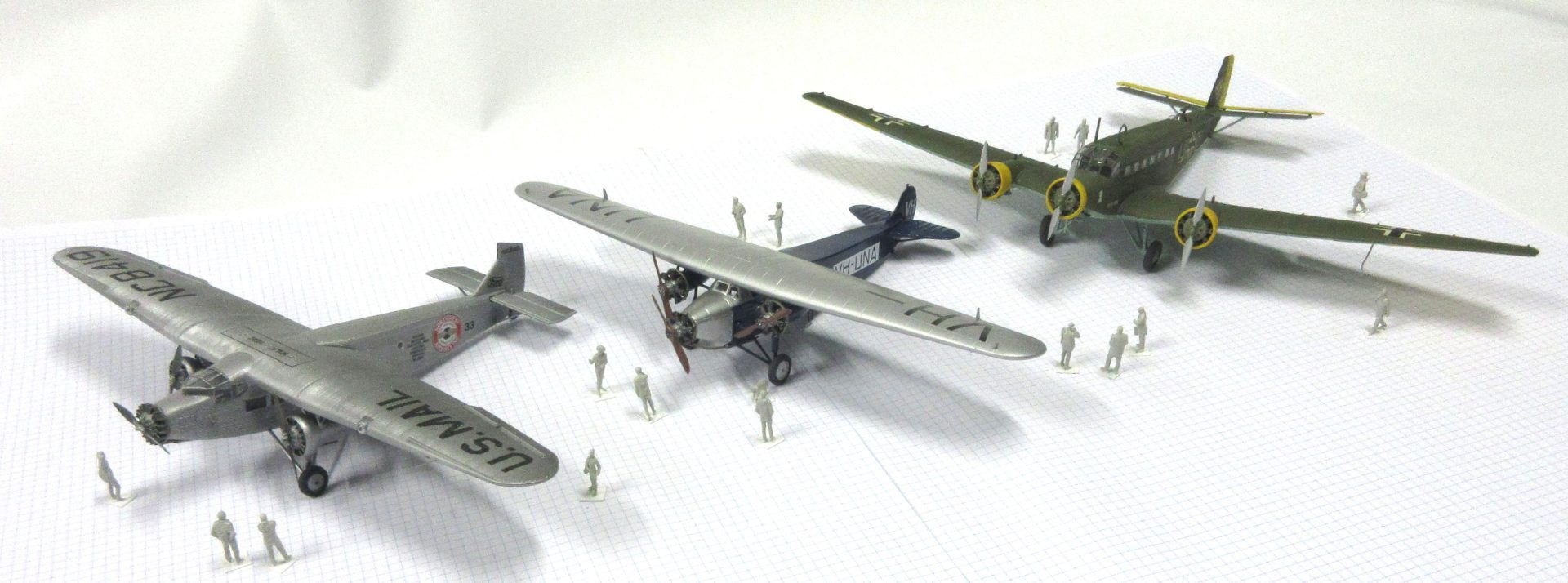Trimotors
Ford 5-AT – Avro 618 Ten – Junkers Ju52/3m

Aircraft with three engines usually come about for lager aircraft that need the power of three engines but are not big enough to need four. This was the case in the 1920s when aircraft designers began working on larger civil aircraft at a time when piston engines were still relatively weak. Three engines also added a level of safety because an aircraft still had adequate power if one engine failed, which was not uncommon in the first couple of decades of aero engine development. Let’s look at the three most popular trimotor aircraft of the inter-war period.
Ford 5-AT in 1/72 by Airfix
This aircraft began as a design of the Stout Metal Aircraft Company in the early 1920s. Henry Ford bought the company in 1925 and development of the original design led to the 4-AT trimotor which first flew in June 1926. It was an all metal aircraft with the wings and fuselage corrogated to give additional strength. It was a major leap forward in air transport when it entered service because it was relatively reliable and comfortable. The 5-AT was a later version with more powerful engines and a lengthened fuselage to increase passenger accommodation. Production continued until 1933 when 199 of these trimotors has been built. They were soon outclassed by the next generation of airliners such as the Boeing 247 and DC-2 but remained in service for many years as cargo aircraft and later for joy riding.
This model was made using the Airfix kit that was first produced in 1968. I thought it was not a bad kit to build, given its age when I finally got around to it. The only other kit of this trimotor that you might consider is the one published by Monogram in 1967 but it is in 1/77 scale and is the earlier 4-AT aircraft. A lot of work can be done to improve this model, for example an interesting but uncompleted built written up in the Britmodeller forum. <<https://www.britmodeller.com/forums/index.php?/topic/235078973-ford-trimotor-modified-airfix-172-kit/page/6/>> For us mere mortal modellers the review on Modelling Madness says the kit is adequate <<https://modelingmadness.com/review/civil/airlines/attard5at.htm>>but the build review on The Sprue Lagoon says ‘It is a horrible kit, with no redeeming features whatsoever’. Perhaps so, but if you want to build a Ford trimotor, what are the options?
Avro 618 Ten in 1/72 by Valom
This aircraft was a version of the Fokker F.VIIB/3m aircraft which was built under licence by Avro for sale in the British Commonwealth (minus Canada). It was called the ‘Ten’ because it has a crew of two and seating for eight passengers. The Fokker version was of convention design for the time with a wooden wing and tube and fabric fuselage. It had first flown as a single engined aircraft but two engines were added to improve performance. The most well known user of the Avro Ten was Australian National Airways which was set up by Charles Ulm and Charles Kingsford Smith in 1930 but went out of service in 1931 due to the Great Depression and the loss of one of its aircraft.
I made this model using the Valom kit which I thought was pretty good but difficult to get right in many respects – which always seems to be the way with Valom kits. It is the only kit available of this particular aircraft but Valom also issue it as Fokker F.VII in any number of boxings. The review of this kit in Modelling Madness summarizes it as a good kit and the review on Wings of Intent goes into the kit in more detail and concludes that it not really a refined kit and ‘ still needs the modeler’s help to shine’. Your other option is the ancient Frog kit that was first published in 1966 and has since been reboxed by ten companies including Hasegawa and Zvezda. If you’ve got it and a rubbish bin now is the time to use them.
Junkers Ju52/3m in 1/72 by Airfix
This aircraft was designed as a transport aircraft, first in a single engined version that first flew in 1930 and later as a three engined version that first flew in March 1932. Like the Ford trimotor it used corrugated surfaces to give additional strength, a method that Junkers pioneered during World War 1. Before World War 2 the Ju52 flew with a dozen airlines as an airliner and cargo aircraft and during that war it became Germany’s main transport aircraft, carrying troops, cargo and serving for a short time as a bomber. Production continued until 1952 and eventually almost 5,000 were built.
This model was made from the Airfix kit which was first published in 1964. It is adequate, let’s say that about it. According to Scalemates this is the only Ju52 kit in this scale but a kit comparison on the Britmodeller forum also mentions kits from Heller and Italeri. This entry begins that the Airfix kit ‘ is very crude in the details and there is no reason to use it for an accurate model having access to other kits’. It goes into detail about the Heller and Italeri kits and suggests that the Heller kit is the better of the two. However, there might not be much difference between them and Brett Green on Hyperscale gives the Italeri kit a recommendation.



